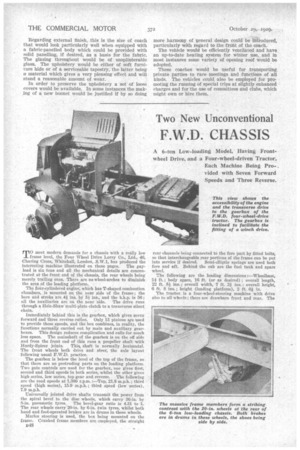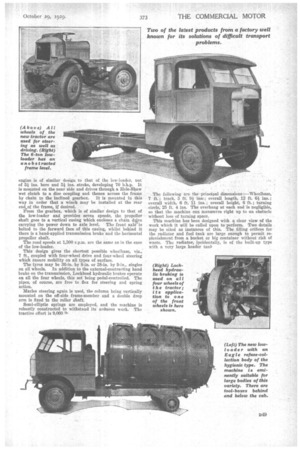Two New Unconventional
Page 114

Page 115

If you've noticed an error in this article please click here to report it so we can fix it.
F.W.D. CHASSIS
A 6-ton Low-loading Model, Having Front wheel Drive, and a Four-wheel-driven Tractor, Each Machine Being Pro-, vided with Seven Forward Speeds and Three Reverse.
TO meet modern demands for a chassis with a really low frame level, the Four Wheel Drive Lorry Co., Ltd., 46, Charing Cross, Whitehall, London, S.W.1, has produced the interesting machine illustrated on these pages. The .payload is six tons and all the mechanical details are concentrated, at the front end of the chassis, the rear wheels being merely trailing ones. There are no wheel-arches to diminish the area of the loading platform.
The four-cylindered engine, which has T-shaped combustion chambers, is mounted on the near side of the frame ; the bore and stroke are.4iins. bY5 ins., and the b.h.p. is 56; all the auxiliaries are on the near side. The drive runs through a HelerShaw.multi-plate clutch to a transverse silent
chain. • Immediately behind this is the gearbox, which gives seven forward and' three reverse. ratios. Only 13 pinions tyre used to provide these speeds, and the box combines, in reality, the functions normally carried out by main and auxiliary gearboxes. This design reduces complication and calls for much less space. The mainsh aft of the gearbox is on the off side and from the front end of this runs a propeller shaft with Hardy-Spicer joints. This, shaft is normally horizontal. The front wheels both drive and steer, the axle layout following usual F.W.D. practice.
The gearbox is below the level of the top of the frame, so that there are no protruding parts on the loading platform. Two gate controls are used for the gearbox, one gives first, second and third speeds in both series, whilst the other gives high series, low series, top gear and reverse. The following are the road speeds at 1,300 r.p.m.:—Top, 21.8 m.p.h.; third speed (high series), 15.9 m.p.h.; third speed (low series), 7.9 m.p.h.
Universally jointed drive shafts transmit the power from the spiral bevel to the disc wheels, which carry 36-in. by S-in, pneumatic tyres. The bevel-gear ratio is 4.31 to 1. The rear wheels carry 20-in. by 6-in, twin tyres, whilst both hand and foot-operated brakes are in drums in these wheels. Merles steering is used, the box being mounted on the frame. Cranked frame members are employed, the straight D48 rear channels being connected to the fore part by fitted bolts, so that interchangeable rear portions of the frame can be put into service if desired. Semi-elliptic springs are used both fore and aft. Behind the cab are the fuel tank and spare wheel.
The following are the leading dimensions :—Wheelbase, 14 ft.; body space, 16 ft. (or as desired) ; overall length, 22 ft. 8i ins.; overall width, 7 ft. 31 ins. ; overall height, 6 ft. 8 ins.; height (loading platform), 2 ft. 01 in.
The tractor is a four-wheel-steering machine with drive stUo to all wheels ; there are drawbars front and rear. The engine is of similar design to that of the low-loader, Cut of 5i ins, bore and 51 ins, stroke, developing 70 b.h.p. It is mounted on the near side and drives through a Ilele-Shaw wet clutch to a disc coupling and thence across the frame by chain to the inclined gearbox. It is mounted in this way in order that a winch may be installed at the rear enctof the frame, if desired.
From the gearbox, which is of similar design to that of the low-loader and provides seven speeds, the propeller shaft goes to a vertical casing which encloses a chain dr.ive carrying the power down to axle level. The front axle. is bolted to the forward face of this easing, whilst behind it there is a hand-applied transmission brake and the horizontal propeller shaft.
The road speeds at 1,300 r.p.m. are the same as in the case of the low-loader.
This design gives the shortest possible wheelbase, viz., 7 ft., coupled with four-wheel drive and four-wheel steering which ensure mobility on all types of surface.
The tyres may be 36-in. by 8-in. or 38-in. by 9-in., singles on all wheels. In addition to the external-contracting hand brake on the transmission, Lockheed hydraulic brakes operate on all the four wheels, this set being pedal-controlled. The pipes, of course, are free to flex for steering and spring action.
Marks steering again is used, the column being vertically mounted on the off-side frame-member and a double drop arm is fixed to the roller shaft.
Semi-elliptic springs are employed, and the machine is robustly constructed to withstand its arduous work. The tractive effort is 9,060 lb The followingare the principal dimensions :—Wheelbase,
ft. ; track, 5 ft. 91 ins;; overall length, 12 ft. 61 ins.; overall width, 6 ft. 11 inc.; overall height, 6 ft. ; turning circle; 25 ft. 4 ins. The overhang at each end-is so that the machine can manteuvre right up to an obstacle without loss of turning space.
This machine has been designed with a clear view of the work which it will be called upon to perform. Two details . may be cited as instances of this. The filling orifices for• the radiator and fuel tank are large enough to permit replenishment from a bucket or big container without risk of waste. The radiator, incidentally, is of the built-up type with a very large header tank




























































































































































































